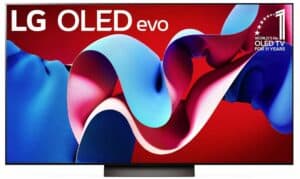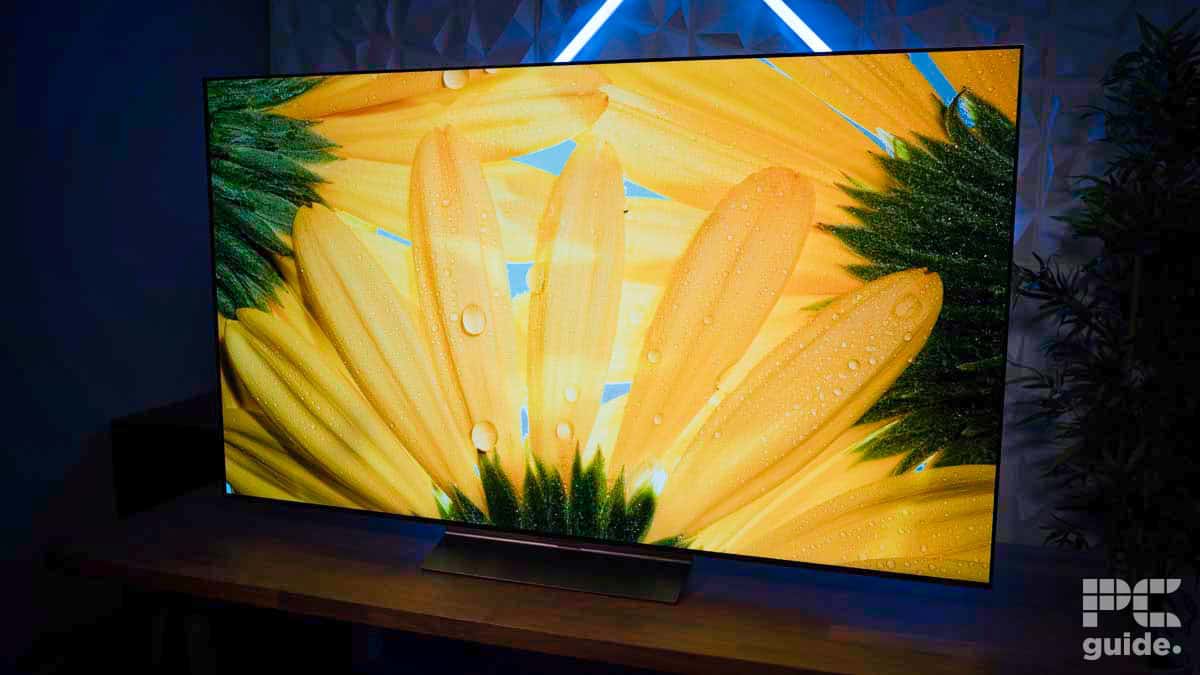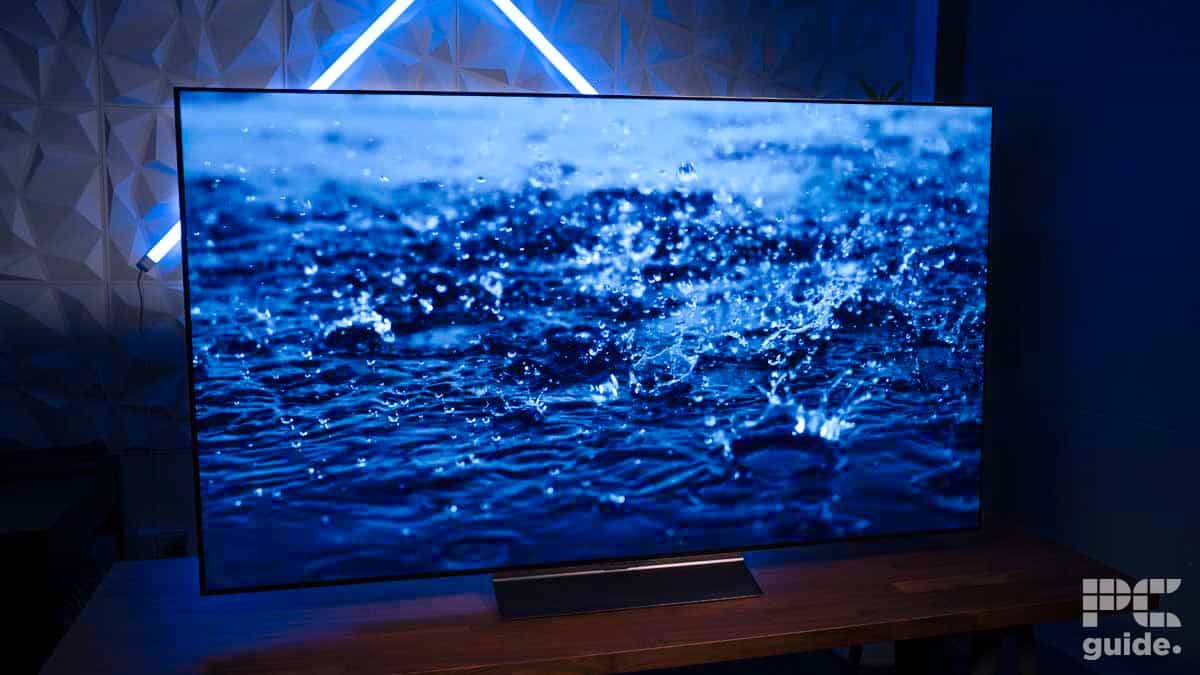LG C4 OLED review (2024)

Table of Contents
Another year, another LG C-series OLED TV (not that we're complaining). One of the best TVs of all time is back in its latest iteration: The LG C4 OLED. With an increased 144Hz max refresh rate (compared to the 120Hz of previous-gen models) and full Nvidia G-Sync certification (meaning less screen tearing) this new model comes with improvements that might be of interest to gamers. It also comes with the latest Web OS 24 operating system, plus an upgraded Alpha a9 AI processor, but is all this worth the extra money? Let's find out.

- Screen Size: 65″
- Resolution: 3,840 x 2,160
- Max refresh rate: 144Hz
- HDR support: HDR10, HLG, Dolby Vision
- Operating system: webOS 24
- I/O: 4x HDMI 2.1 (48Gbps), 3x USB, 1x LAN, 1x optical digital output, 1x RF & satellite, 1x IR blaster port
- Dimensions: 56.7″ x 32.5″ x 1.8″ (without stand)
- Weight: 36.6lbs (without stand)
All in all the LG C4 is another great OLED TV from LG, with some welcome gaming-focused improvements, however, for most people the upgrades won't be worth the additional asking price relative to the LG C3, which has dropped significantly in price. Still, if you do want the latest, slightly brighter model and/or are a keen gamer, then it remains a great purchase you won't regret.
- fantastic OLED panel with perfect blacks, contrast ratio & excellent response time
- 144Hz refresh rate & full G-Sync support
- improved brightness relative to the C3
- improved speaker quality vs the C3
- speaker quality remains behind some of the competition
- asking price quite steep for only modest improvements vs previous gen
- advertising section on WebOS 24 is annoying
Pricing
The particular model we were sent for testing was the 65-inch C4 OLED. At the time of writing, this has an MSRP of $2,699.99, though we've seen it reduced in price to around the $2,300 mark. The preceding 65-inch C3 started with an MSRP of $2,599 but this reduced after a year to around the $1,600 mark; we may see this trend repeated with the C4.
Prime Day is finally here! Find all the biggest tech and PC deals below.
- Sapphire 11348-03-20G Pulse AMD Radeon™ RX 9070 XT Was $779 Now $739
- AMD Ryzen 7 7800X3D 8-Core, 16-Thread Desktop Processor Was $449 Now $341
- ASUS RTX™ 5060 OC Edition Graphics Card Was $379 Now $339
- LG 77-Inch Class OLED evo AI 4K C5 Series Smart TV Was $3,696 Now $2,796
- Intel® Core™ i7-14700K New Gaming Desktop Was $320.99 Now $274
- Lexar 2TB NM1090 w/HeatSink SSD PCIe Gen5x4 NVMe M.2 Was $281.97 Now $214.98
- Apple Watch Series 10 GPS + Cellular 42mm case Smartwatch Was $499.99 Now $379.99
- ASUS ROG Strix G16 (2025) 16" FHD, RTX 5060 gaming laptop Was $1,499.99 Now $1,274.99
- Apple iPad mini (A17 Pro): Apple Intelligence Was $499.99 Now $379.99
*Prices and savings subject to change. Click through to get the current prices.
The price points of all the other size variants are as follows (note that these are subject to change):
- LG OLED42C4PUA (42”): $1,499.99
- LG OLED48C4PUA (48”): $1,599.99
- LG OLED55C4PUA (55”): $1,999.99
- LG OLED65C4PUA (65”): $2,699.99
- LG OLED77C4PUA (77”): $3,699.99
- LG OLED83C4PUA (83”): $5,399.99
One important point: whilst all the larger sizes are essentially the same besides their dimensions, the 42-inch and 48-inch models do not come with the same Brightness Booster tech (meaning they'll be slightly dimmer) although they do both have headphone jacks, which the rest of the TVs lack. The 42” model also only has a 20W 2.0 speaker system, compared to the 40W 2.2 system on the other models.
The C4 is not the most advanced model in the LG OLED range, that accolade goes to the G4, which costs considerably more (the 65” version has an MSRP of $3,399), and comes with an improved MLA panel and more powerful chipset, though is significantly thicker in its dimensions.
Design & specifications
From the front, the LG C4 is almost identical in appearance to the C3, but this is no bad thing, given its one of the nicest-looking sets around. The majority of the screen area is strikingly thin, with the thicker central section that houses the connection ports (masked behind the screen) still only being 4.7cm at its broadest point. The front of the screen looks glossy, with the majority of the rear now having an interesting matte coating that looks a bit granite-like in texture (a change from the C3).
The glossy screen does obviously mean you'll experience some reflections, more than you would on the MLA panel on the LG G4 with its improved anti-reflective coating, however, the screen gets sufficiently bright that this shouldn't be an issue in most indoor scenarios. The bezels round the screen are extremely thin, making for a great viewing experience.
Construction of the C4 is relatively straightforward, though as ever with a TV of this size with a screen this thin we'd recommend having at least two people put it together (it's really not worth the risk in breaking such an expensive piece of kit). The stand is the same metallic-looking component that the previous model had and feels sturdy enough. Indeed the whole TV feels well put together, which is what we've come to expect from LG products.
Screen Size
65″
Resolution
3,840 x 2,160
Max refresh rate
144Hz
HDR support
HDR10, HLG, Dolby Vision
Operating system
webOS 24
I/O
4x HDMI 2.1 (48Gbps), 3x USB, 1x LAN, 1x optical digital output, 1x RF & satellite, 1x IR blaster port
Dimensions
56.7″ x 32.5″ x 1.8″ (without stand)
Weight
36.6lbs (without stand)
Inside the box you get a remote control with 2x AA batteries, the usual user manuals and stickers, plus an IR blaster kit to extend the range of your remote
The ‘Magic Remote' included in the box is the same as that used by the LG C3, which can be used as a pointer or in the more conventional fashion with the buttons. The TV also supports hands-free voice control should you wish to use this.
The I/O selection is also the same as with the C3: you get three USB ports, four 48Gbps HDMI 2.1 inputs, a LAN socket, optical digital output, RF and satellite connections, plus an IR blaster port.
The C4 supports 4K/120 HFR (High Frame Rate) with Dolby Vision. As mentioned you get NVIDIA G-Sync support as well as AMD FreeSync Premium and VRR.
The more advanced Alpha a9 AI chipset (compared to the Alpha a9 Gen 6 in the C3) helps with upscaling and motion processing, helping the TV reach the 144Hz refresh rate in games. You also get an ALLM (Auto Low Latency Mode) and a gaming menu and optimizer to enhance your gaming experience further.
OSD, features & settings
The Web OS 24 operating system the C4 runs on will support updates for at least the next five years. At present it performs similarly to Web OS 23, which is no bad thing: it's fast and responsive when switching between menus, with plenty of streaming apps included (Netflix, Disney+, Prime Video, Apple TV etc. plus localised streaming services) and even Nvidia GeForce Now for game streaming should you want this.
New features in Web OS 24 include personalized recommendations on the Home Page, improved Quick Cards (they're now smaller on the screen and dynamically reveal information when you hover above them), password protection for user accounts, an Accessibility tab to more easily access these features, and built-in Chromecast support.
In terms of downsides, the advertising section that usually takes up over 1/3 of the screen when you’re on the main menu is quite annoyingly obtrusive, and a waste of screen real estate compared to the actual useful functions.
Audio
The audio on the C4 is noticeably better than that of the C3, but still a bit disappointing considering the price point. The peak volume of the 40W speakers is definitely not as high as we would have liked and audio clarity is lacking even at these volumes, with the set also vibrating in a distracting way during loud moments. We'd certainly recommend picking up a soundbar instead.
Screen testing
From a subjective viewing experience the C4 looks great, but there's no surprise there: every LG C-series TV we've seen has been a pleasure to use. The TV did seem slightly brighter than previous models, particularly in HDR mode, and this was reflected in the test results below, though besides this you're unlikely to notice much difference in the picture quality.
Color gamut, accuracy & picture quality
Below are the results we got for the LG C4 OLED using the i1DisplayPlus colorimeter and DisplayCAL software. We've listed the ideal result for each data point on the top row, and below this the recorded results for each pre-set, without calibration, out of the box.
Game Optimizer mode was the best overall in terms of being as close as possible to the ideal values, though obviously in real world scenarios whichever you opt for is down to subjective taste.
On the whole the picture was fairly warm, being quite a bit below the 6500K white point on most presets. As you'd expect from an OLED panel, the black point and contrast ratio were both effectively perfect. Gamma results were reasonable, although color accuracy suffered on every preset other than Game Optimizer mode (an average deltaE*00 score of 2.5 or below is what you want really).
| white | black | contrast | average deltaE*00 | gamma | brightness | |
| IDEAL | 6500K | 0/m² | infinity:1 | 0 | 2.2 | n/a |
| Standard mode | 5651K | 0/m² | infinity:1 | 3.39 | 2.05 | 247cd/m² |
| Expert bright mode | 4513K | 0/m² | infinity:1 | 3.9 | 1.92 | 200cd/m² |
| Cinema mode | 4501K | 0/m² | infinity:1 | 4.11 | 1.94 | 158cd/m² |
| Game optimizer mode | 5847K | 0/m² | infinity:1 | 1.97 | 2.07 | 206cd/m² |
In terms of gamut coverage the DCI-P3 results were slightly worse than we expected (we'd have liked to have seen closer to 100%), but still respectable. Based on this, professional color work could be conducted in the sRGB space, but perhaps not in the wider DCI-P3 gamut.

Brightness
We always test the peak brightness, minimum brightness and what brightness setting equates to 120cd/m², as this is the approximate value for natural light. The results of this can be seen below when the TV was tested on the Standard preset in SDR mode. We've also listed the peak brightness from when the screen was tested with HDR mode enabled.
SDR mode
100 brightness: 255.35 cd/m²
0 brightness: 46 cd/m²
34 Brightness: 120 cd/m²
HDR mode
100 brightness: 932 cd/m²
For an OLED TV, these results are pretty good, and beat the last older-gen C-series TV we tested: the LG C2.
Panel uniformity
The last major test we do is for panel uniformity: this measures how consistent the luminance and colors are across the whole screen. The screen is divided into a 5×5 grid, with the central square used as the reference point; every other square is then tested to see how far it differentiates from this reference square.
With any variance below 1.00 the square appears as green, and this is the ideal result. Yellow represents a greater degree of variation between 1.00 – 3.00, however this is still unlikely to be discernible by the naked eye, and doesn't preclude the display from color accurate work. Greater variance is more of a problem, and shows up as orange then red.

As we can see in the image above, the LG C4 performed well, with a high degree of uniformity overall. The greater degree of variation in the second column from the left (shown by the yellow squares) is still within acceptable limits and will likely be imperceptible to the naked eye.
Viewing angles
As with virtually all OLED TVs, the C4 has excellent viewing angles: there's limited color shift when you view the on-screen image from the side, indeed color is still pretty visible even as you approach the 180° mark.

LG C4 65-inch OLED (OLED65C46LA)


















